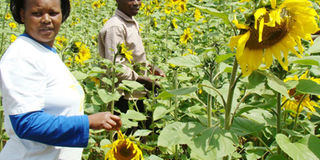Out goes maize, in comes sunflower

Viola Rogony, a farmer at Kapsang village in Soy Division, Uasin Gishu County and a worker at the farm inspect a sunflower crop on July 23, 2012. A manufacturing firm has entered into partnership with farmers in Tharaka-Nithi County to increase supply of soya beans and sunflower seeds. PHOTO | JARED NYATAYA | NATION M EDIA GROUP
What you need to know:
- Benter takes the good seeds for processing to produce oil at Matangwe Hospital, where there is a milling machine.
The yellow flowers shine brightly on the farm in Matangwe, Siaya County.
Grown on one acre, the sunflower patch stands out from the other farms teeming with maize and beans, the main crops grown in the region.
Benter Achola, the owner of the farm, walks from one sunflower plant to another looking at how they are growing. “It is about a year since I started planting sunflower. Initially I was growing maize.”
Benter embraced sunflowers after piloting the crop with the help of Village Level Bio Fuel Group — a community-based organisation.
“I joined the group, which gave me and other interested farmers 1kg packet of sunflower seeds each to plant,” she says.
From half a kilo of seeds she planted on half an acre, she harvested eight 45kg bags of sunflower seeds — an equivalent of 20 litres of sunflower oil. About four kilos of sunflower seeds produce a litre of oil, which goes at Sh300.
Water is good for the plants but too much of it will loosen the soil and make the roots weak,” advises Benter, who grows the Sunbeam variety, which is excellent for snacks and making of poultry feeds.
“The crops thrive in warm to hot climates with full sunshine during the day. The soil should be slightly acidic, with a pH of between 6.0 and 7.5. Sunflowers mature after three months. An acre takes a kilo of seeds.”
“Before putting the seeds in the hole, one should apply fertiliser mixed with soil. This will encourage development of strong roots to protect the crops from breaking or bending when strong winds blow because sunflowers can be tall,” explains George Omondi of Village Level Bio Fuel Group, who trains farmers on how to grow the crop, whose market is unlimited and can grown across the country.
The plants, he adds, should be sowed 30 inches apart to allow space for the branches to spread out.
To know whether the plant is ready for harvesting, the head turns brown at the back. This happens about 30 to 45 days after bloom. At this time, seed moisture is about 35 per cent. “The head is cut from the plant about 4 inches below the flower and then the seeds removed. This can be done manually or using a machine.”
The seeds are then dried until the moisture content is below one per cent.
“I, thereafter, rinse thoroughly the seeds with running water to remove most dirt that may have gathered on them while they were drying,” explains Benter.
Produce oil
“I then dry the seeds again and separate the full ones from the broken ones.”
Benter takes the good seeds for processing to produce oil at Matangwe Hospital, where there is a milling machine.
“The last time I harvested in May, I got 60 litres of oil, which I sold locally and used some for cooking. I got Sh30,000 from the oil and other sunflower by-products. This is better than maize, which takes about six months to mature.”
Benter further mills the seeds after extraction of oil and sells them to poultry and dairy farmers.
“After grinding, I sell a kilo at Sh100. From this I am able to get money which I can use in buying fertiliser and tilling the land.”
However, growing sunflowers comes with challenges. “Moths attack the crops. Birds are another challenge because they feed on the seeds.”
She applies insecticides early in the morning or late afternoon to prevent the chemicals from affecting bees, which are the pollinators.
Sunflower oil is rich in vitamin E and low in saturated fat hence lowering cardiovascular diseases and chance of heart attack, says Captano Wanjohi, a clinical nutritionist with Healthwise Consultants in Nairobi.
“The saturated fats found in other oils are difficult to break down completely during metabolism.”





